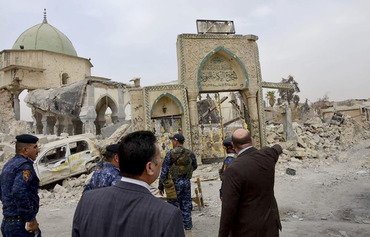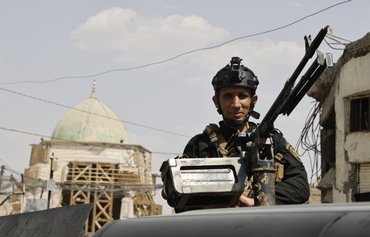Iraqis on Sunday (December 16th) laid the cornerstone to rebuild Mosul's al-Nuri mosque and leaning minaret, national emblems destroyed last year in the battle against the "Islamic State of Iraq and Syria" (ISIS).
Abu Bakr al-Baghdadi made his only public appearance as ISIS chief from the famed 12th century mosque and al-Hadba (hunchback) minaret in 2014.
The structures were ravaged three years later in the final, most brutal stages of the months-long fight to rid Mosul of ISIS.
On Sunday, dozens of government officials, religious figures, UN representatives and European ambassadors gathered in the large square in front of the battered mosque to see the foundation laid.
![Abdullatif al-Humaym, head of Sunni Endowments in Iraq, places the cornerstone for the rebuilding of al-Nuri mosque and al-Hadba minaret in Mosul’s Old City, during a ceremony on Sunday (December 16th). [Zaid al-Obeidi/AFP]](/cnmi_di/images/2018/12/17/15817-Nuri-mosque-cornerstone-600_384.jpg)
Abdullatif al-Humaym, head of Sunni Endowments in Iraq, places the cornerstone for the rebuilding of al-Nuri mosque and al-Hadba minaret in Mosul’s Old City, during a ceremony on Sunday (December 16th). [Zaid al-Obeidi/AFP]
![A picture taken on December 16th shows the remains of al-Hadba (hunchback) minaret in Mosul’s Old City. [Zaid al-Obeidi/AFP]](/cnmi_di/images/2018/12/17/15819-Hadba-minaret-remains-600_384.jpg)
A picture taken on December 16th shows the remains of al-Hadba (hunchback) minaret in Mosul’s Old City. [Zaid al-Obeidi/AFP]
Abdullatif al-Humaym, the head of Sunni endowments in Iraq, set down the stone during a simple ceremony.
More than a year after ISIS lost control of Mosul, the iconic mosque still lies in ruins. The stone gate leading up to its courtyard and the greenish dome now covered in graffiti are virtually the only parts still erect.
All that is left of the minaret is part of its rectangular base, the rest of it sheared off by fighting.
According to Abu Bakr Kenaan, head of Sunni endowments in Ninawa, remnants of the minaret will be preserved, while other parts of the mosque will be built afresh, along with a museum about its history and adjacent homes.
The five-year project will be financed by a $50.4 million donation from the UAE.
'A journey of physical reconstruction'
The first year will focus on documenting and clearing the site, while the next four years will see the physical restoration, UNESCO has said.
The mosque's destruction "was a moment of horror and despair", said UNESCO Iraq representative Louise Haxthausen.
"Today as we lay the foundation stone of al-Nuri mosque, we are starting a journey of physical reconstruction," she told those gathered.
The mosque takes its name from Nureddin al-Zinki, who ordered it built in 1172 after unifying Syria and parts of northern Iraq.
Its cylindrical minaret, which featured several levels of ornamental brickwork capped by a small white dome, started listing centuries ago.
It is featured on Iraq's 10,000-dinar banknote and gave its name to countless restaurants, companies and even sports clubs.
But in June 2014, it became infamous as the site where al-Baghdadi declared ISIS's "caliphate" just days after the group seized Mosul in a lightning assault.
That capture prompted three years of ferocious fighting to wrest back Mosul and other Iraqi cities overrun by ISIS.
In June 2017, as Iraqi forces closed in on a shrinking ISIS-held pocket in Mosul's Old City, the group blew up both al-Nuri mosque and its leaning minaret.
When the rest of the Old City fell back under state control, Iraqi forces celebrated at the mosque.

![A picture taken December 16th shows the remains of al-Nuri mosque and al-Hadba leaning minaret in Mosul’s Old City, during the ceremony to place the corner stone. [Zaid al-Obeidi/AFP]](/cnmi_di/images/2018/12/17/15818-Nuri-mosque-ruins-600_384.jpg)






